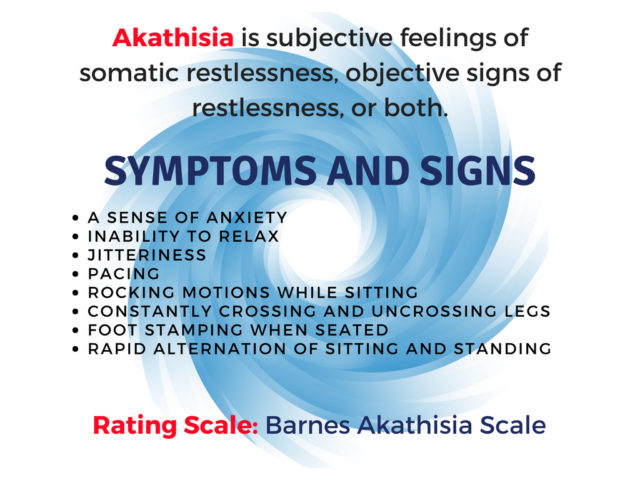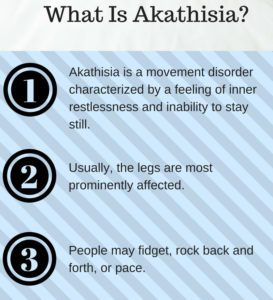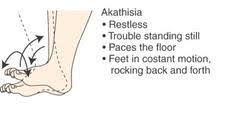
Akathisia [pronounced: ak-ah-thĭ´zhah] is a movement disorder characterized by a feeling of inner restlessness and a compelling need or urge to be in constant movement. Sometimes actions including rocking while sitting or standing, lifting the feet like marching on the spot and/or crossing/uncrossing the legs while sitting are seen in patients presenting with akathisia. People with akathisia are unable to sit or keep still, complain of restlessness, fidget, rock from foot to foot, and pace.
 Many psychiatric drugs themselves can cause akathisia, including benzodiazepines. Other known causes include drug withdrawal from nearly any physical dependence causing drug, including benzodiazepines. Severe movement disorders, which may become permanent in some people, include Tardive Dyskinesia (TD), tardve akathisia, and dystonia and are associated with long-term use of dopaminergic drugs such as antipsychotics. “Tardive” means that the movement disorder may appear even after the offending drug is stopped. Akathisia may range in intensity from a sense of disquiet or anxiety, to excruciating discomfort, Some patients may pace for hours. Sitting or lying down, if they can manage, does not relieve the akathisia. Many patients show very little outer movement, and the akathisia affects the sufferer inside, causing feelings of despair, agitation, intense panic and worry, and/or an augur of disaster that feels completely real. Healy, et al. (2006), described the following regarding akathisia: tension, insomnia, a sense of discomfort, motor restlessness, and marked anxiety and panic. Increased labile affect can result, such as weepiness. Some patients have described the feeling as a sense of inner tension and torment or chemical torture. Many sufferers describe the feeling like they want to “peel off their own skin.”
Many psychiatric drugs themselves can cause akathisia, including benzodiazepines. Other known causes include drug withdrawal from nearly any physical dependence causing drug, including benzodiazepines. Severe movement disorders, which may become permanent in some people, include Tardive Dyskinesia (TD), tardve akathisia, and dystonia and are associated with long-term use of dopaminergic drugs such as antipsychotics. “Tardive” means that the movement disorder may appear even after the offending drug is stopped. Akathisia may range in intensity from a sense of disquiet or anxiety, to excruciating discomfort, Some patients may pace for hours. Sitting or lying down, if they can manage, does not relieve the akathisia. Many patients show very little outer movement, and the akathisia affects the sufferer inside, causing feelings of despair, agitation, intense panic and worry, and/or an augur of disaster that feels completely real. Healy, et al. (2006), described the following regarding akathisia: tension, insomnia, a sense of discomfort, motor restlessness, and marked anxiety and panic. Increased labile affect can result, such as weepiness. Some patients have described the feeling as a sense of inner tension and torment or chemical torture. Many sufferers describe the feeling like they want to “peel off their own skin.”
Severe akathisia can become a very harrowing experience. Jack Henry Abbott (1981) describes the sensation:
…[It comes] from so deep inside you, you cannot locate the source of the pain … The muscles of your jawbone go berserk, so that you bite the inside of your mouth and your jaw locks and the pain throbs. … Your spinal column stiffens so that you can hardly move your head or your neck and sometimes your back bends like a bow and you cannot stand up. … You ache with restlessness, so you feel you have to walk, to pace. And then as soon as you start pacing, the opposite occurs to you; you must sit and rest. Back and forth, up and down you go … you cannot get relief …
Neuropsychologist Dr. Dennis Staker had drug-induced akathisia for two days. His description of his experience:
It was the worst feeling I have ever had in my entire life. I wouldn’t wish it on my worst enemy.
Many patients often find a hard time describing the incomprehensible pain and movement from severe akathisia, as it is so far beyond the realm of “normal” human experience that it cannot be put into words. Although this adverse effect (akathisia) disappears quickly and remarkably when the medication is stopped for some, tardive, or late-persisting akathisia may go on long after the offending drug is discontinued, sometimes for a period of years. Sometimes, too, the akathisia only starts when the benzodiazepine drug is discontinued and is a result of the withdrawal, as opposed to the drug’s presence. Akathisia is a medical emergency when it is severe as the patient may be at very high risk for suicide. If you, your family member or friend are experiencing severe akathisia with suicidal ideation, please seek immediate medical attention from a neurologist that is educated on akathisia and its high risk of suicide or from the nearest emergency room.

Unfortunately, many medical professionals don’t recognize akathisia or that it’s a drug-induced state. Instead, they write off the symptoms as a “worsening of mental illness” or other condition. Sometimes they even raise the dose of the offending drug and when the patient’s condition worsens as a result, they may prescribe more medication which can sometimes further exacerbate the problem or that fail to offer relief. If the medical professionals you encounter are ignorant about akathisia or attempt to blame it on “something else”, present them with medical information on the condition or search until you find a knowledgeable physician. The presence and severity of akathisia can be measured using the Barnes Akathisia Scale.
The following video of Stephanie Eisensmith was submitted by her daughter. Stephanie took Klonopin exactly as prescribed by her doctor for a little over ten years (far longer than the recommended 2-4 weeks). She was not warned of its physical dependence or withdrawal-causing potential. She stopped taking it cold turkey, not knowing that a long, slow taper was required to discontinue it properly. She endured the cold-turkey withdrawal for months. However, due to the severity of the withdrawal syndrome, she then tried to reinstate the benzodiazepine for a week and a half which failed to offer the relief she sought. She took her life on 10/21/16 from the Sunshine Skyway Bridge in Tampa, Florida. Stephanie left us with this video that she made during her suffering in an attempt to educate others and the public about the akathisia she was enduring from benzodiazepine withdrawal. Her daughter has granted permission for W-BAD to post it here as an educational tool and in hopes of sparing others a similar fate. Let Stephanie’s suicide be a warning to others about the severe and distressing nature of akathisia in some patients and that it is a medical emergency not to be taken lightly.
Click on CC for captions in English. To contribute translations of this video in another language, click here.
The movements Stephanie is experiencing in the video above are known as “pill rolling” movements and are common in akathisia sufferers.
This next video is of Josh Jensen, a well-known case of medication-induced movement disorders, although the psychiatric medications he was poly drugged on causing his movement disorder were not mentioned: